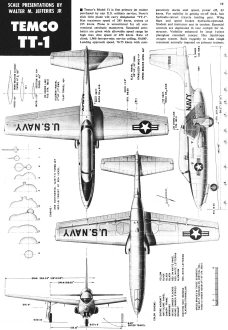|
Walter M. Jefferies, Jr., was
one of the premier illustrators for model aircraft magazines in the era that
this 4-view drawing of the
Temco TT−1 "Pinto" jet appeared in American Modeler magazine. The
Pinto was designed to be a rugged military trainer. Temco (Texas Engineering &
Manufacturing Company ) was in competition with
Cessna Aircraft's T−37
"Tweet" ( an embarrassing name) which we all know by now based on its
familiarity won the bid. Once you have heard the loud, extremely high pitched
sound of the T−37 sitting on the tarmac, you'll never forget it. A primary
difference between the two airplanes is that the Pinto was a tandem seating
arrangement, while the Tweet was side-by-side. I would have given a month's pay
when I was in the USAF to be able to get a ride in a T−37. Of course month's pay
for a non-NCO airman back in the 1970's was a pittance, so it would have been a
cheap ride.
Temco TT-1
 Scale Presentations by Walter M. Jefferies Jr. Scale Presentations by Walter M. Jefferies Jr.
Temco's Model 51 is first primary jet trainer purchased by any U.S. military
service; Navy's slick little plane will carry designation "TT-1". Has maximum speed
of 285 knots, cruises at 235 knots. Plane is unrestricted for all conventional aerobatic
maneuvers. Sustained aerobatics are given wide allowable speed range by high max
dive speed of 450 knots. Rate of climb, 1,900 feet-per-min; service ceiling, 30,000'.
Landing approach speed, 70-75 knots with comparatively docile stall speed, power
oft, 63 knots. For stability in getting on-off deck, has hydraulic-retract tricycle
landing gear. Wing flaps and speed brakes hydraulic-operated. Student and instructor
seat in tandem. Essential controls are duplicated in rear cockpit for instructor.
Visibility enhanced by large 1-piece plexiglass clamshell canopy. Has liquid-type
oxygen system. Built ruggedly to take rough treatment normally imposed on primary
trainers.
Posted February 4, 2023
|